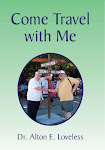
Since we had visited the home of James Madison the previous time we were in the area. We decided that we would visit the home of James Monroe. Of the three presidential homes in this area, it seems to be the house that is the least impressive.
Also located near Charlottesville, Virginia, and adjacent to Thomas Jefferson's Monticello, is the estate of James Monroe, fifth President of the United States. Purchased in 1793, Monroe and his family permanently settled on the property in 1799 and lived for twenty-four years. Personal debt forced Monroe to sell the plantation in 1825.
President Monroe simply called his home "Highland." It did not acquire the additional name of "Ash Lawn" until after his death.
Encouraged by his close friend, Thomas Jefferson, Monroe purchased a deed for one thousand acres of land adjacent to Monticello in 1793 for an equal number of pounds from the Carter family. The land formerly had been a part of the Blenheim Plantation owned by Champe Carter. In 1800, Monroe described his home as: "One wooden dwelling house, the walls filled with brick. One story high, 40 by 30 ft. Wooden Wing one storey high, 34 by 18 ft."
Following I am including some of the history of this estate.
Over the next 16 years, Monroe continued to add on to his home, adding stone cellars and a second story to the building. He also expanded his land holdings, which at their greatest included over 3,500 acres However, by 1815, Monroe increasingly turned to selling his land to pay for debt. By 1825, he was forced to sell his home and the property.
Edward O. Goodwin purchased Highland from Monroe at twenty dollars an acre and often referred to the property as "North Blenheim." At the time of the purchase, Monroe described Highland as containing: "a commodious dwelling house, buildings for servants and other domestic purposes, good stables, two barns with threshing machine, a grist and sawmill with houses for managers and laborers . . . all in good repair."
Goodwin sold the house and six hundred acres in 1834 and it was sold again in 1837 to Alexander Garrett. Garrett gave the property its second name which remained with it to the present day, "Ash Lawn." Over the course of thirty years, Ash Lawn–Highland was sold numerous times until 1867, when John Massey purchased it. It remained in the possession of the Massey family for the next sixty-seven years. In that time period, the family added to the house, whereupon it took on its present day appearance.
Ash Lawn–Highland was sold for the last time in 1930 to philanthropist Jay Winston Johns of Pittsburgh, Pennsylvania. The Johns family soon after opened the house to public tours and upon his death in 1974, Johns willed the property to James Monroe's alma mater, the College of William and Mary.
This house seems to be more remote than the other two presidents, but I am glad I can say we visited it. The drive is a few mile farther for the Jefferson house but was a beautiful route.
While another couple, who travels with us often, viewed the interior of the house, I soon departed the tour to sit down and later walked the grounds.
In my Father's house are many mansions: if it were not so, I would have told you. I go to prepare a place for you.-- John 14:2 (KJV)








